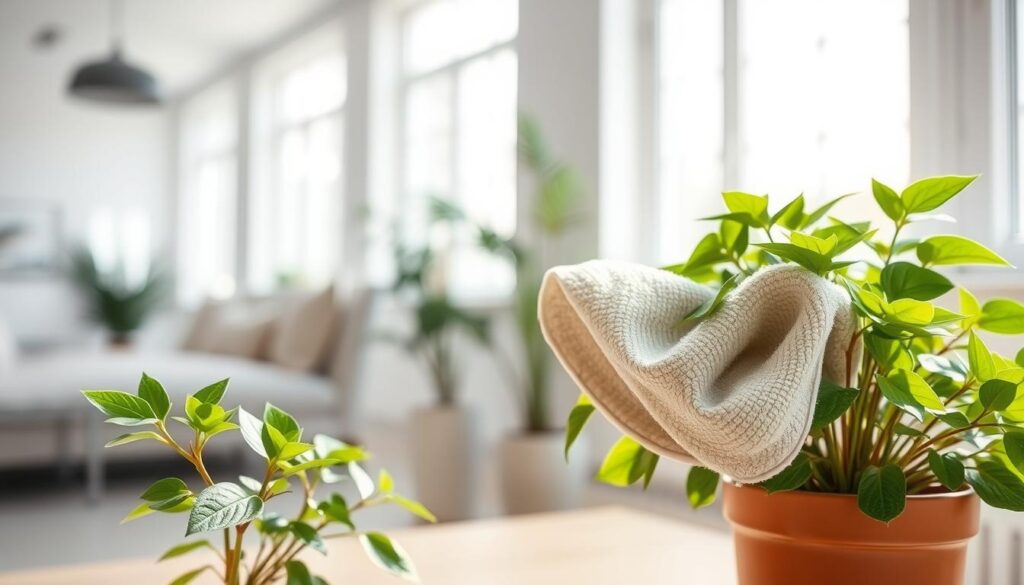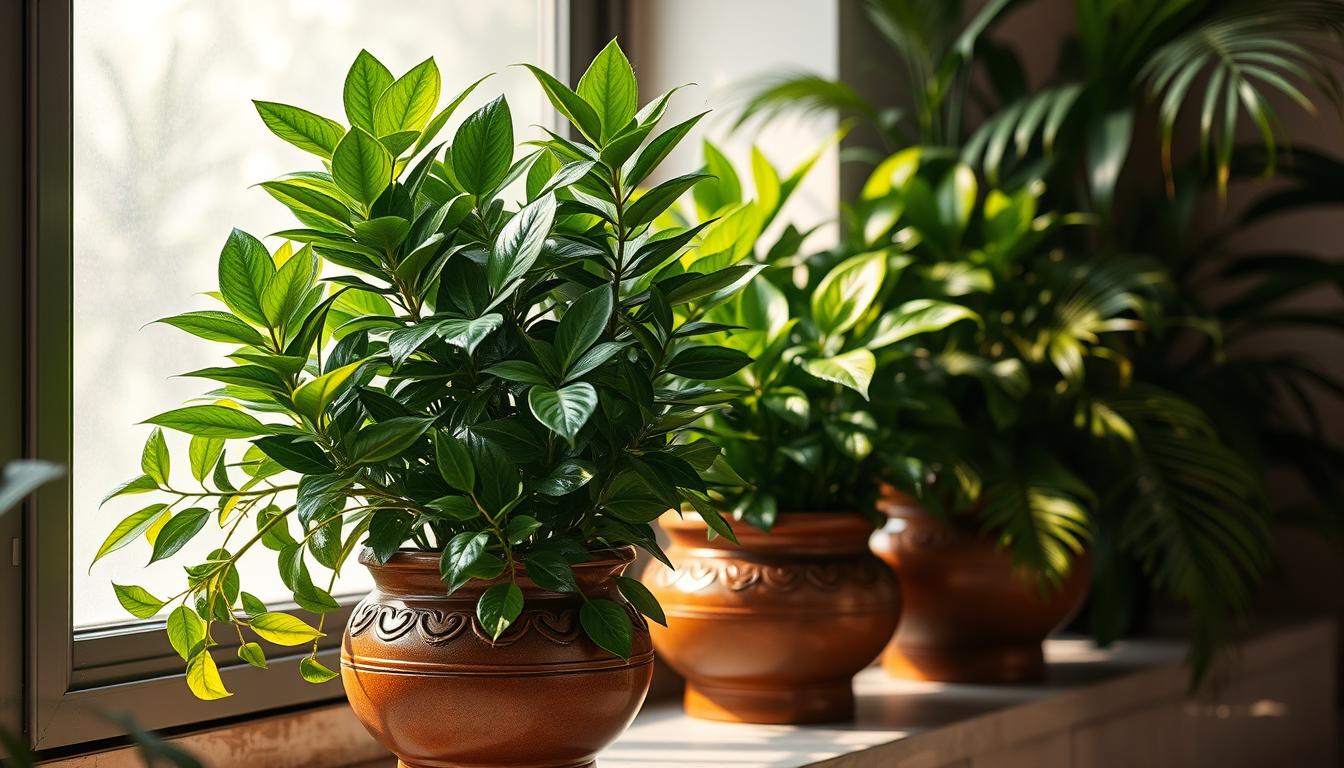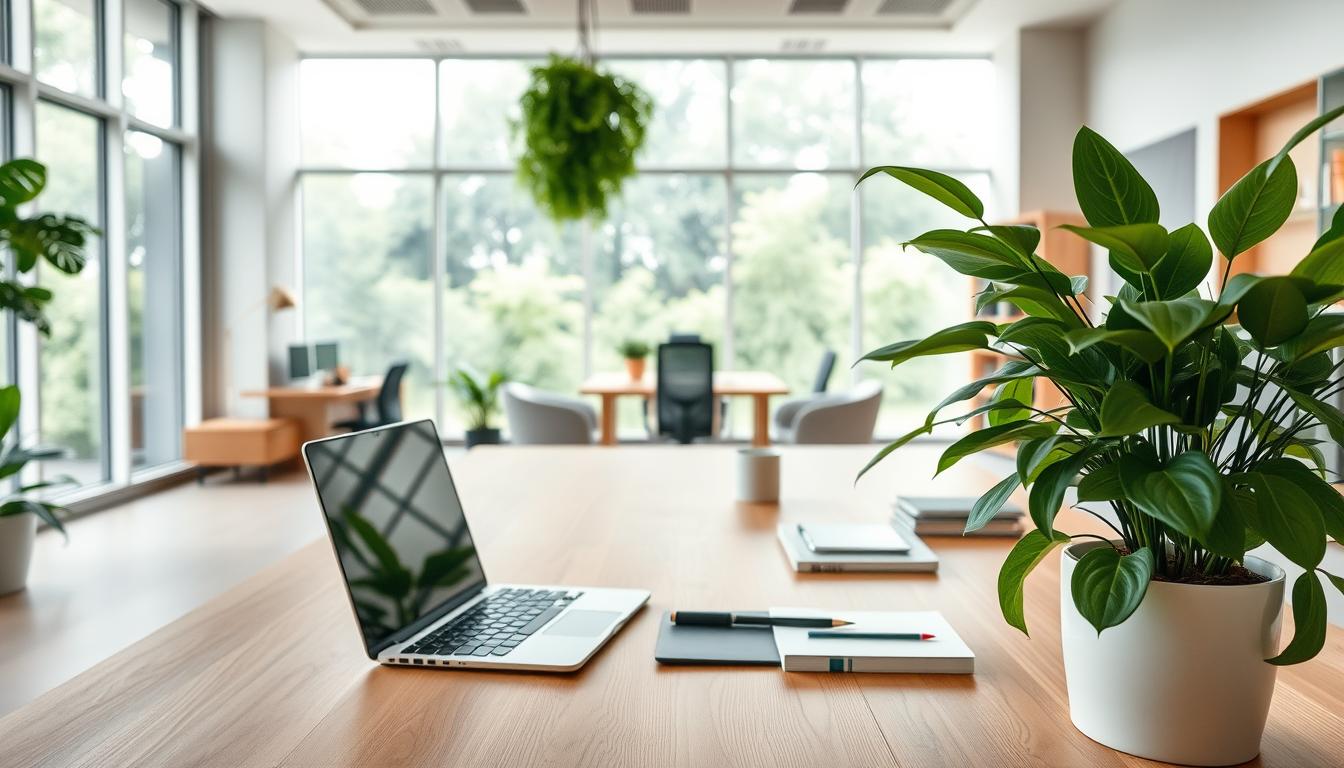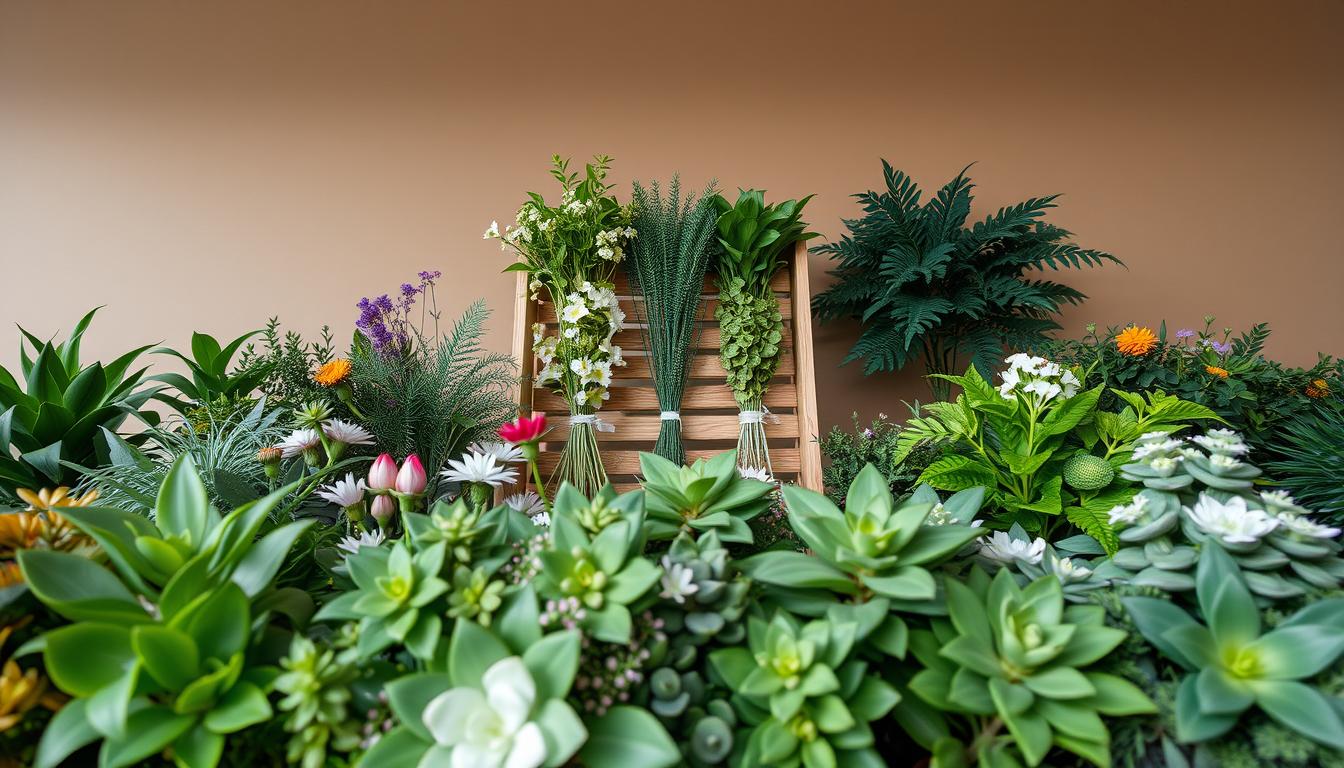Artificial indoor plants brighten up your home without the need for constant upkeep. Yet, dust builds up on them over time, reducing their charm. Learning effective dust removal tricks is vital for both their looks and durability. This article will guide you on keeping your faux plants clean. That way, they’ll remain an enduring part of your decor.
Understanding the Importance of Cleaning Artificial Plants
Keeping artificial plants clean is key to making them look beautiful and improving your space. It is very important because regular cleaning removes dust. This makes indoor air better and healthier. By taking care of artificial plants, they stay looking great and keep your decor lively.
The Benefits of Maintaining a Dust-Free Environment
A home without dust offers many perks. Let’s look at some:
- Improved visibility and light reflection in the room.
- Reduction of allergens and respiratory irritants in the air.
- Enhanced overall aesthetic maintenance, contributing to a fresher look.
These aspects make your living space more welcoming and pleasant.
How Dust Accumulation Affects Aesthetics
Dust buildup can make artificial plants lose their real look. If not cleaned, they might:
- Lost their shine and details.
- Look old and ignored, possibly needing replacement.
Cleaning regularly keeps artificial plants looking real. This lets them add to your home decor instead of spoiling it.

Basic Dusting Techniques
Keeping artificial plants clean is key to their beauty. The right cleaning tools drastically improve dust removal. They also protect the plants’ delicate parts. Learning about cleaning can make upkeep easier and more thorough.
Choosing the Right Tools for Dusting
Starting with the right tools is vital for artificial plant care. Here are top choices:
- Microfiber cloths: They’re great at catching dust without harming surfaces.
- Feather dusters: Their lightness and flexibility help clean hard-to-reach spots.
- Soft paintbrushes: They gently clean fragile leaves and flowers without damage.
Regular Dusting Frequency Recommendations
To keep artificial plants looking new, dusting regularly is crucial. Dusting every few weeks stops dirt from building up. Use soft cloths to clean every leaf and branch carefully. Consider your plants’ materials as you clean. Regular care boosts their look and extends their life.
Dust Removal Techniques for Artificial Indoor Plants
Keeping artificial indoor plants looking fresh needs effective dust removal strategies. You can choose from different methods depending on the plants’ design and material. Using the right techniques for dust removal not only makes the plants look better but also helps them last longer.
Common Methods to Dislodge Dust Effectively
To keep artificial plants looking bright and clean, you have a few options:
- Microfiber cloths are perfect for softly wiping surfaces without causing any scratches.
- Compressed air can get into tight spots, knocking dust loose successfully.
- Vacuums with soft brush attachments gently remove dust from fragile leaves.
Choosing the right cleaning method helps clean thoroughly while protecting the plants.
Impact of Regular Maintenance on Lifespan
Cleaning artificial plants often greatly affects how long they last. Dusting and washing regularly can stop dust from harming the materials over time. By looking after your artificial plants well, they will stay beautiful and useful for a long time.
Using Compressed Air for Hard-to-Reach Areas
Compressed air cleaning is great for removing dust from tight spots on artificial plants. It cleans well without harming the plants, unlike some other cleaning methods.
How to Safely Utilize Compressed Air
To clean dust off without causing damage, compressed air is your go-to. Here’s what to do for the best clean:
- Maintain a distance of several inches between the canister and the plant.
- Apply brief bursts of air rather than sustained pressure to reduce the risk of damage.
- Direct the air towards crevices and textured surfaces to dislodge stubborn dust particles.
Recommended Air Pressure Levels to Prevent Damage
Using the right air pressure is key to safe cleaning with compressed air. Too much pressure can break delicate parts. Stick to these tips:
- Using low air pressure settings, typically around 20-30 PSI, for delicate plants.
- Avoiding excessive force to prevent dislodging smaller decorative elements.
- Testing the air flow on a less visible area to gauge the effects before cleaning prominently visible spots.
Deep Cleaning Techniques for Stubborn Dust
Regular dusting might not always do the job for tough grime on fake plants. When you need a deeper clean, it’s important to use the right methods. Two good ways include soap and water for sturdy materials, and a vinegar mix for fragile fabrics.
Soap and Water Method for Durable Materials
Using soap and water is easy for cleaning tough artificial plants. Just mix mild soap with water to make a gentle cleaner. Soak the plants quickly to loosen dirt.
After soaking, softly scrub them with a cloth or sponge. Make sure to rinse them well to avoid leaving soap behind.
Using a Vinegar Solution for Delicate Fabrics
For materials like silk, cleaning with a vinegar solution is safer. Combine equal parts white vinegar and water in a spray. Then, lightly spray the fabric to let the mix tackle the dust.
Gently wipe with a soft cloth to protect the material. This method also gets rid of smells, making the fabric smell nice.
Vacuuming Your Artificial Plants
Vacuum cleaning is a smart way to care for larger artificial plants. These plants often gather dust quickly. Using the right vacuum attachments is key to cleaning them well and safely.
Choosing the Right Vacuum Attachments
Choosing the correct vacuum attachments is vital for keeping artificial plants looking great. The soft brush attachment is the top choice for gentle cleaning. It avoids scratching or harm to the plants’ delicate parts. For hard-to-reach spots or detailed arrangements, use a narrow nozzle. It cleans every nook without damage.
Best Practices for Vacuuming Without Damage
To clean without hurting your plants, use a low suction setting on your vacuum. Start from the top and move downwards. This method ensures dust falls and gets caught, covering all surfaces well. Cleaning regularly keeps your artificial plants in top shape and makes them last longer.
Utilizing Hairdryers for Quick Dust Removal
Turning a hairdryer to the cool setting is a smart way to get rid of dust on faux plants. It’s perfect for parts that are hard to clean because they catch dust easily. The hairdryer gives fast results, which makes it a favorite for keeping plants looking fresh.
Tips for Effective Use of a Hairdryer
For the best results with this cleaning method, follow these tips:
- Keep the hairdryer far enough from the plant to avoid damage.
- Use quick air bursts to knock dust off without hurting the leaves.
- Focus on areas that need more cleaning.
Preventing Overheating During Cleaning
It’s important to manage the heat when using a hairdryer for dust removal. Here’s how:
- Only use the cool setting on your dryer.
- Use it in short spurts to avoid getting too hot.
- Watch the plant for any damage signs while cleaning.
Using these smart cleaning tips will keep your artificial plants looking great without harm. This method can significantly make cleaning easier and preserve your plants.
Preventing Dust Buildup on Artificial Plants
Keeping artificial plants clean needs a good plan. It’s very important to have smart storage ideas to cut down on dust. When artificial plants are in areas with a lot of dust, they get dirty fast. This means you need to clean them often. Knowing the best ways to show off your plants and using sprays to fight dust can help keep your plants looking new.
Storage and Display Tips to Minimize Dust
Here are some tips to prevent dust on your artificial plants:
- Keep artificial plants away from windowsills or areas prone to dust storms.
- Utilize covered containers for storing plants when they are not in use.
- Display plants on shelves at higher levels to avoid common dust pathways.
The Role of Anti-Dust Sprays in Maintenance
Using anti-dust sprays for artificial plants helps keep them clean. These sprays make it harder for dust to stick to the plants. If you use them regularly, it creates a shield that simplifies cleaning later. Picking high-quality products can make your cleaning routine less frequent. This ensures your plants keep looking bright and beautiful.
Maintaining Artificial Plants for Long-Term Freshness
Taking care of artificial plants requires effort and planning. Set up a regular cleaning timetable and inspect them often. This helps keep their appearance fresh and adds beauty to any room.
Establishing a Routine Cleaning Schedule
It’s important to have a cleaning plan for your fake plants. Regular cleaning stops dust from building up and keeps the plants looking bright and lively. Here are some tips:
- Dusting every week to keep surfaces clean.
- Deep cleaning once a month to tackle built-up grime.
- Seasonal checks to refresh and maintain the overall appearance.
Regular Inspections for Damage or Wear
Checking your artificial plants regularly is key. This helps to spot any damage or wear early on. Be sure to look for:
- Fraying fabrics or loose leaves.
- Fading colors due to sunlight exposure.
- Structural integrity of the plant base and stem.
Making time for these inspections means you can fix issues quickly. This way, your artificial plants will always look great, whether they’re in your home or office.
Conclusion
Learning how to clean artificial indoor plants well can really make them look better and last longer. Using different ways to clean, like dusting often and doing a deep clean, helps keep your fake plants looking fresh.
Keeping artificial plants clean does more than just make them look nice. It also helps keep your home’s air cleaner and adds to the beauty of your space. By cleaning your plants regularly, they’ll keep adding charm and freshness to your home.
When you make dusting and cleaning your plants a regular task, they become a lasting part of your home’s style. This means you can have a beautiful, green space for a long time. It’s all about keeping them clean and taking good care of them.



